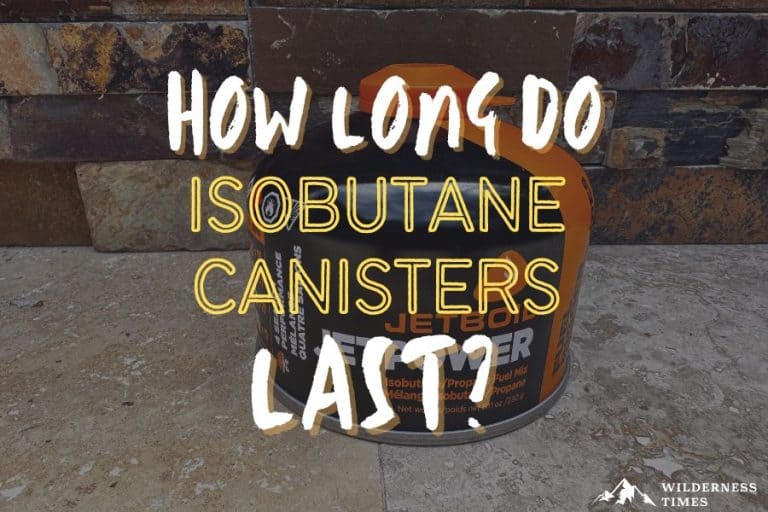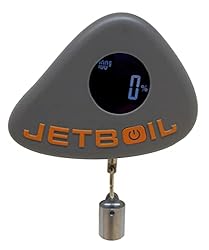After a long day of adventuring, it’s always amazing to eat a hot meal.
However, stove fuel can sometimes be difficult to budget and plan for.
In this article we’re diving into how much isobutane fuel you really need for your campout – and how to tell when you’ve got enough.
But the short answer is that an 8 oz container will last anywhere from 1.5 to 3 hours:
Table of Contents
ToggleHow Long Do Isobutane Canisters Last?
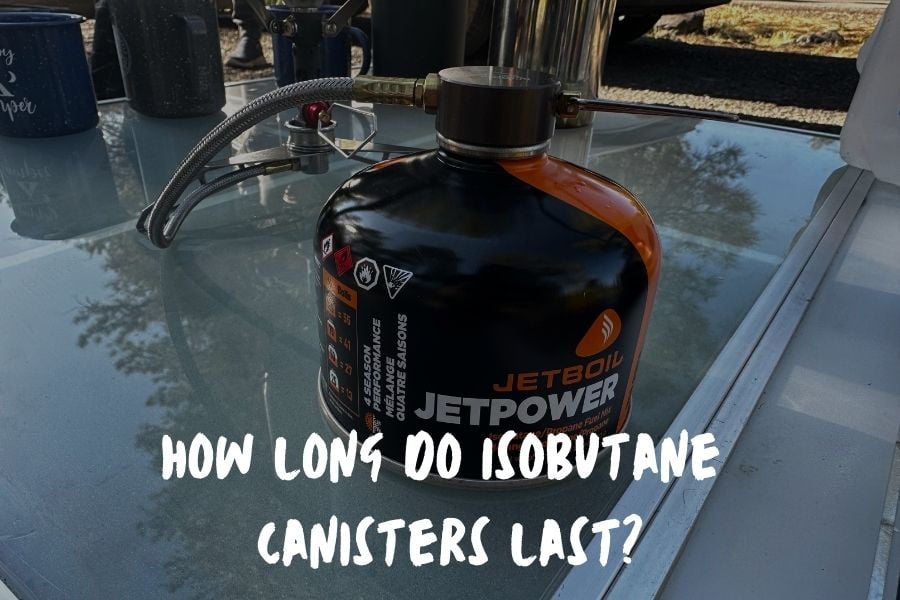
As a general rule of thumb, an 8 oz canister of isobutane fuel will sustain anywhere from 1.5 to 3 hours of burn time.
The variance in this timing depends on many factors: latent temperature, burn strength, and frequency of use throughout your camping adventure all have an effect.
But on average, here is what you can expect:
| Size of Canister | Volume | Continuous Burn Time |
| Small | 3.5 oz | 30-40 mins |
| Medium | 8 oz | 1.5 – 3 hrs |
| Large | 16 oz | > 3 hrs |
Uses & Benefits Of Isobutane Canisters In Camping
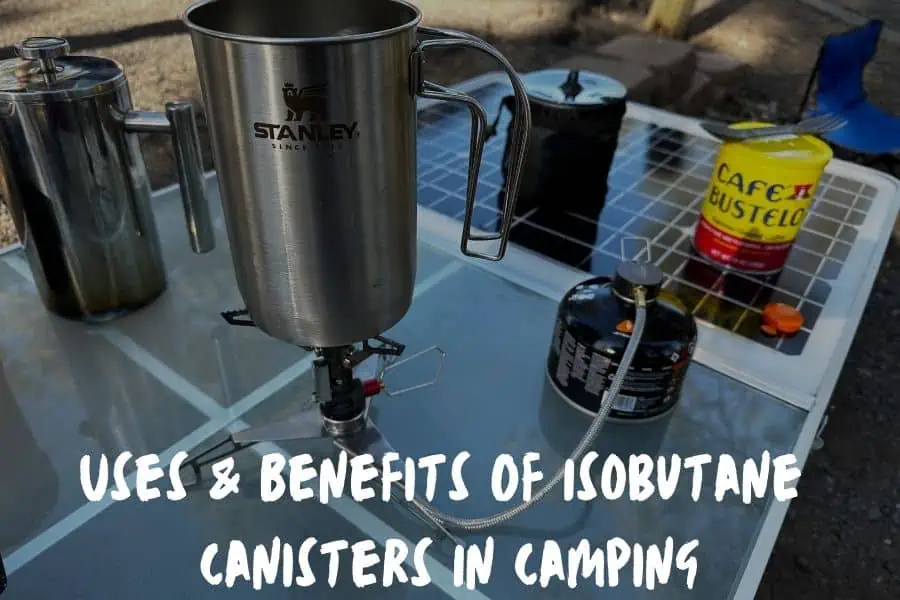
Isobutane is a great fuel option for camping because it’s generally compact and has a great weight-to-efficiency ratio.
In comparison to other liquid fuels, isobutane also has a higher vapor pressure.
This means that it is better at pushing gas through the stove, making it the most efficient gas to use with a stove attachment.
Additionally, high vapor pressure means that the fuel will still work well in moderate to cool temperatures.
So, you can depend on isobutane to heat your water – even in slightly chilly conditions.
However, if you’re planning on using your stove during especially cold conditions, you will want to use propane because works most efficiently in cold weather.
There are also canisters of isobutane and propane mixtures that will work in these conditions as well.
Isobutane Canister Lifespans
Average Lifespan Of Small, Medium, & Large Canisters
The lifespan of isobutane canisters depends on how large each canister is, and how much space there is for gas.
The following table will cover the lifespan of each size canister:
| Size of Canister | Volume | Continuous Burn Time |
| Small | 3.5 oz | 30-40 mins |
| Medium | 8 oz | 1.5 – 3 hrs |
| Large | 16 oz | > 3 hrs |
Variability In Lifespan Based On Usage
Even with canisters of the same size, there is a variance in lifespan based on usage and environment.
A large part of how long your canisters will last you on a campout depends on how often you use the fuel throughout the day.
On average, most campers will use their stove in the morning to heat up drinks and/or oatmeal, then again at dinner to heat up a warm meal.
However, if you’re planning on skipping the stove for breakfast, you’ll be able to use less fuel throughout the trip.
Additionally, when I’m out on the trail, I usually plan for a “cold” lunch, since it can be more efficient in the middle of your day – and saves a good amount of fuel.
Even with the advantages of high vapor pressure, using fuel in colder environments will use the fuel faster than in warmer ones.
This is because the fuel needs to work harder for longer to heat up objects that are the same temperature as the surrounding cold environment.
How To Determine The Remaining Fuel In Isobutane Canisters
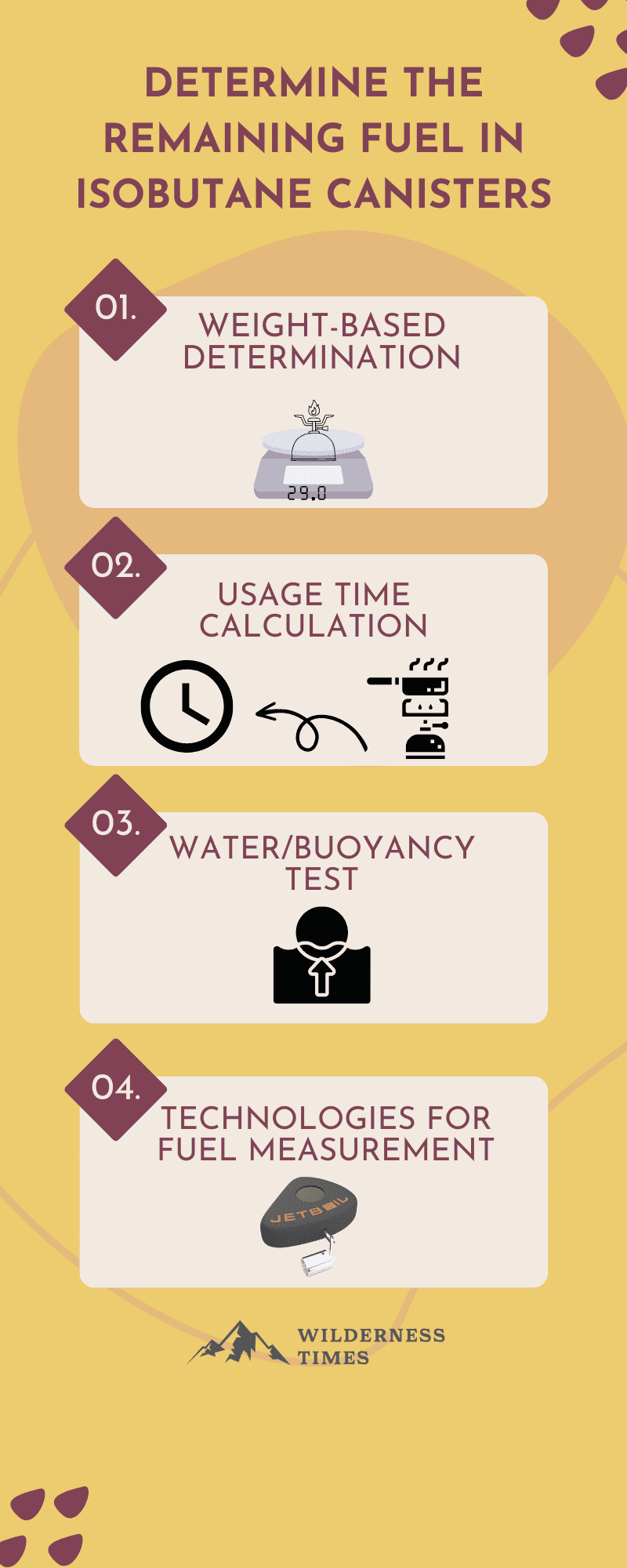
Weight-Based Determination
This technique will require a partially used canister, a full canister, and a kitchen scale.
Weigh the full container to get its weight, then the partially used one.
The difference between the two weights will tell you how much fuel is left in the partially filled container.
Usage Time Calculation
In general, an 8 oz container will last anywhere from 1.5 to 3 hours.
While this is a fairly large range, you’ll get to know how long your stove lasts with the 8 oz canister once you’ve used it a few times.
Once you’re familiar with how your stove works with the given fuel amount, you’ll know how long the fuel will last you.
Keeping that time in mind will help you budget for how much fuel to bring.
Water/Buoyancy Test
One of the easiest ways to figure out how much fuel is left in the container is to place the canister in a bowl or pot of water.
Once the canister has been completely submerged, it will float at the point of fuel.
Once you take the canister out of the water, the water line on the metal will reflect where the fuel is.
To keep everyone safe during this test, it’s important that the water used is cold or lukewarm.
Do not use warm, hot, or boiling water for this test as it can cause higher pressure inside the canister and cause an explosion.
Available Technologies For Fuel Measurement
If you’re willing to spend a bit more money, there are a few advanced technologies that can help you figure out how much fuel is left in the canister.
One example is the Jetboil Fuel Measure. This tool connects to the canister and tells you exactly how much fuel is left in the container.
Also see: What Fuel Does Jetboil Use?
Factors Affecting The Lifespan of Isobutane Canisters
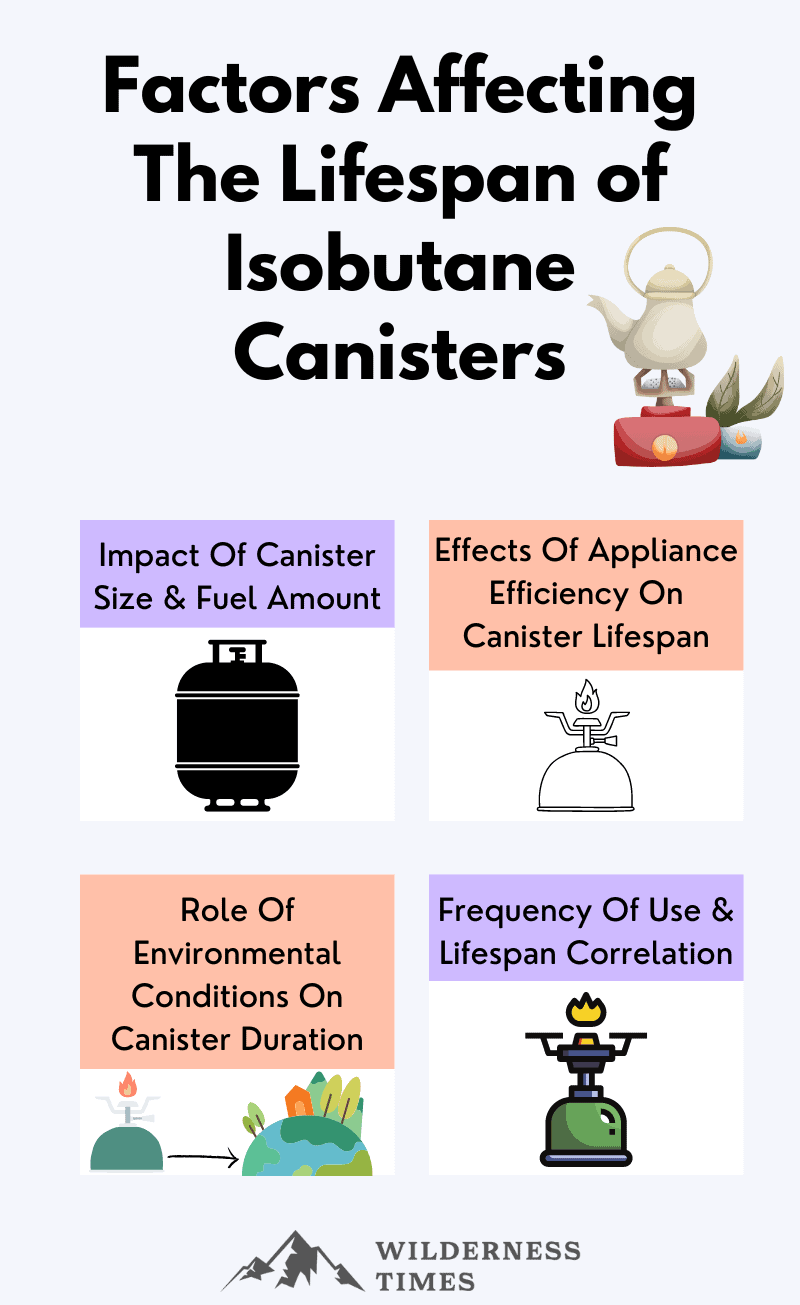
Impact Of Canister Size & Fuel Amount
In general, larger canisters will hold more fuel, which will, in turn, last you longer on your campout.
However, when I go camping I try to stay away from the largest canisters and tend more towards the 4 oz and 8 oz size containers.
This is because the weight of the fuel will be easier to distribute throughout your pack if they are in smaller containers.
Plus, empty canisters will be easier to discard along the way.
Effects Of Appliance Efficiency On Canister Lifespan
How much gas your stove requires to operate can really affect how long your gas will last you on the trail.
When your stove is older, it may require more gas because it uses it less efficiently.
Additionally, the older your stove is, the more likely it is to have micro-leaks where the compartments connect.
These micro-leaks can lead to less efficient gas usage.
See: Types of Camping Stoves (Pros/Cons of Each Stove Type)
Role Of Environmental Conditions On Canister Duration
Colder conditions will use more fuel than warmer conditions.
This is because the rest of your items that need to be heated are already at the colder temperature of the weather outside.
Therefore, it’ll take more effort to heat your food up.
Because of this, using fuel in cold weather will decrease the amount of burn time possible for any given canister.
Frequency Of Use & Lifespan Correlation
The more you use your fuel throughout the day, the quicker it will run out – and the shorter the fuel lifespan will be.
If you’re trying to conserve fuel on your campout, try to use your stove less often throughout the day.
Check out the next section for more tips on extending the lifespan of your isobutane canisters on the trail, and when you get home.
Tips For Extending The Lifespan Of Isobutane Canisters
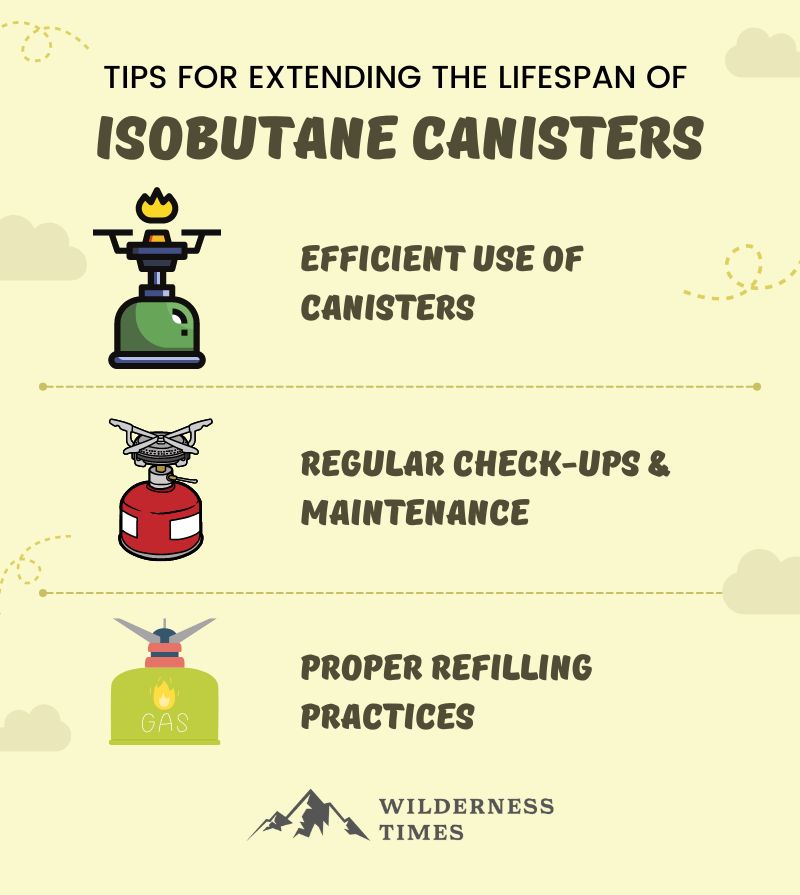
Efficient Use Of Canisters
When you’re out on the trail, using your fuel the most efficiently as possible will ensure that your canister will last longer.
This means that using your fuel only when needed and cooking food in advance will lengthen the lifespan of your canisters.
If you’re really trying to conserve fuel, I recommend only using the fuel for dinner.
For the rest of your meals, you can have cold breakfasts and lunches, which won’t require a stove or fuel use.
Additionally, when you’re cooking your dinner, make sure that all of your ingredients are prepped before you start cooking.
This way, the fuel that you’re using will be used as efficiently – and only when needed.
Read: 16 Camping Food Ideas (No Cooking, No Refrigeration)
Regular Check-Ups & Maintenance
It’s important that you are regularly maintaining and checking on the quality of the containers.
Especially check around the opening parts where they connect to the stove lines.
Visible cracking around the plastic opening, rust on the metal, or fraying off the stove lines could mean that the canister is no longer safe for use.
Proper Refilling Practices
One canister can be refilled multiple times before it needs to be disposed of.
If you’re comfortable working with gas, or have prior experience, you can refill them yourselves.
Check out the video below for more information:
However, if you want to get additional help refilling your fuel canisters, you can get help from your local outdoors store.
Proper Storage & Handling Of Isobutane Canisters
Best Practices For Safe Handling
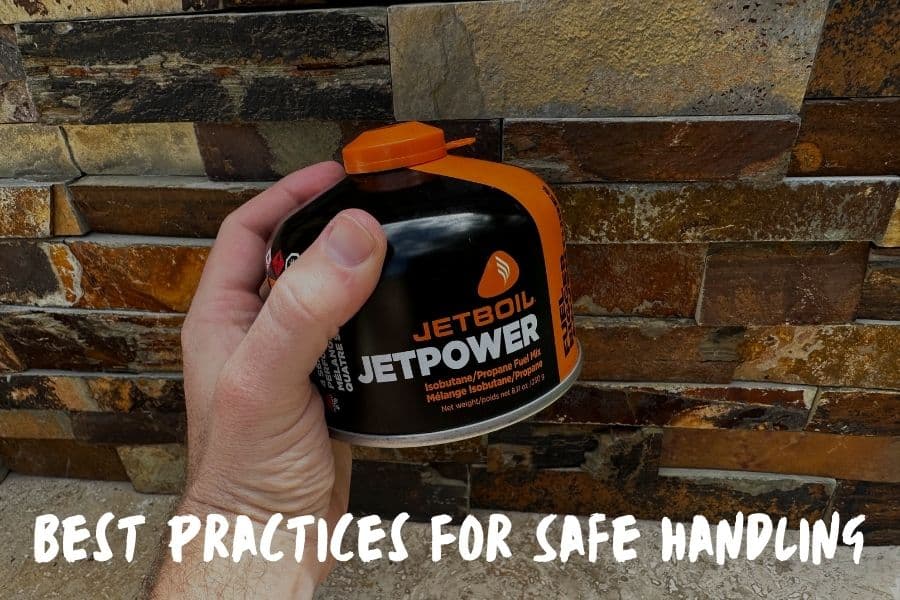
It’s always important to keep yourself safe when dealing with liquid gas and fuel.
To keep yourself safe, make sure to keep the fuel away from sources of heat, like open flame and machinery.
When the canisters are exposed to too much heat, the fuel inside will increase in pressure, creating the potential for an explosion.
Additionally, keep the fuel canisters away from sharp objects that could puncture the sides and cause a gas leak.
Storage Guidelines For Isobutane Canisters
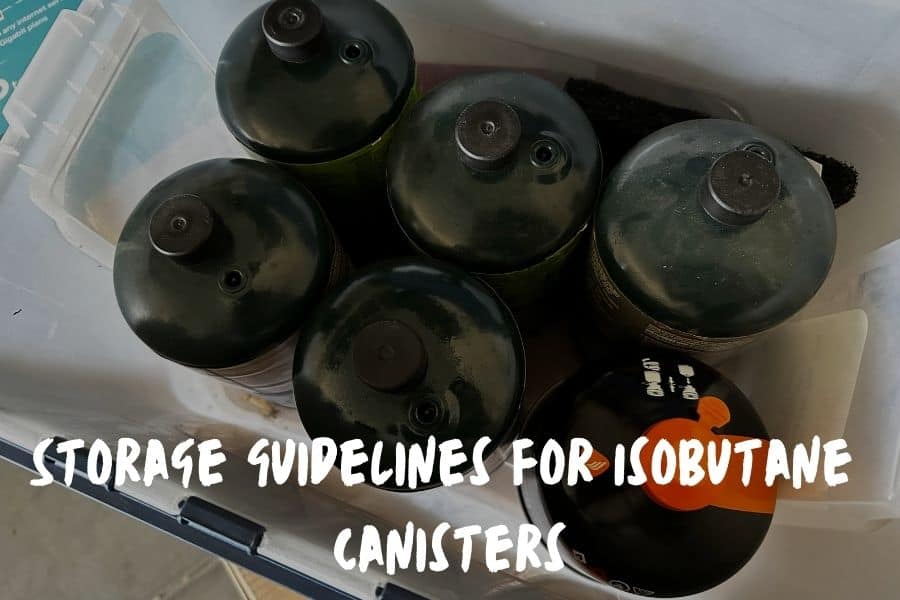
Since isobutane canisters hold liquid gas, it’s essential that you store them correctly to avoid any risk of gas leak, fire, or explosion.
To store isobutane canisters safely, make sure that they are placed in a cool, dry environment away from any sharp objects.
Also, make sure that the environment does not have any risk of becoming hot.
Stay away from storage areas that can become hot in the warmer seasons, or next to machinery that can get hot with use.
Transportation Tips For Isobutane Canisters
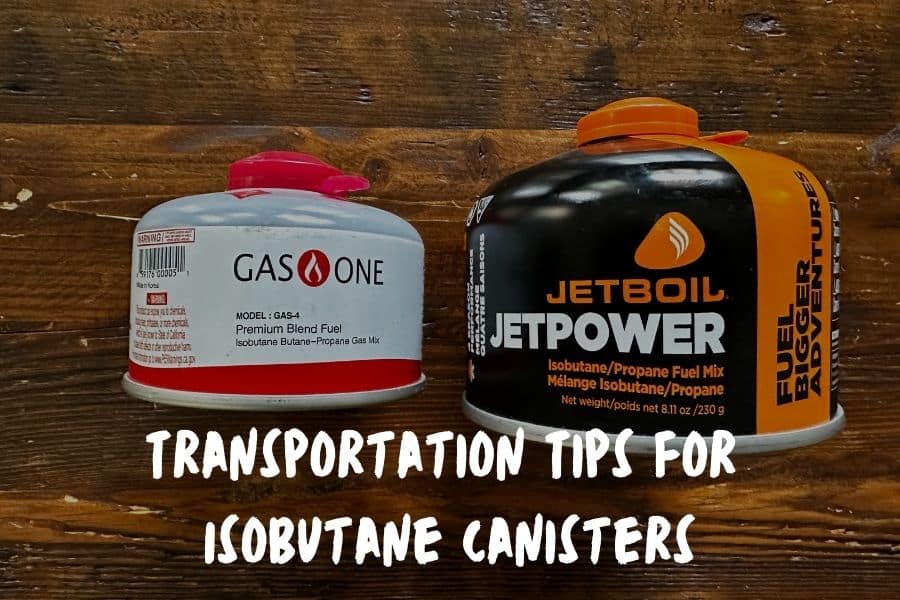
As we’ve mentioned above, it’s essential to keep your canisters away from heated environments.
When you’re transporting isobutane canisters in a vehicle, you have to take additional measures to ensure that they do not overheat.
Do not, under any circumstances, park in direct sunlight where the trunk or interior of the car can overheat.
Additionally, if your car has a separate trunk, be sure to place the canisters there, rather than in the interior of the car.
If you know you’ll be driving in warm weather conditions, you can also place your canisters in a cooler to keep the temperature down.
FAQs
Are All Isobutane Canisters The Same?
No, even though the contents and canister materials are the same, the canisters that hold the isobutane can vary by shape and size.
Are Isobutane Canisters Recyclable?
Yes, empty canisters are made of steel and plastic, so they can be recycled as mixed metal.
How Do You Dispose Of Isobutane Canisters?
Before you dispose of the isobutane canister, make sure that the container is completely empty by “venting” the canister, or leaving the container open for the gas to escape.
Once you’re sure that the container is empty, push a hole in the wall of the container.
You can use a screwdriver for this step.
After you have punched the wall in the side of the container, you can safely recycle the containers with participating services.
Can You Refill Isobutane Canisters?
Yes, the canisters themselves are generally refillable.
However, gas can be a dangerous substance, so it’s important to do your research before attempting this, or to consult a professional on the subject.
Do Isobutane Canisters Expire?
No, isobutane canisters do not expire. Because of this, you can use isobutane canisters that are up to a few decades old.
The most important thing to keep in mind for aging gas canisters is if the container is still viable.
If the metal and plastic on the gas container looks warped or worn, it could be dangerous to use the gas inside.
Can Isobutane Canisters Be Refilled, Or Should I Buy A New One Every Time It Gets Empty?
You do not have to buy a new canister every time it’s emptied! Instead, you can refill the containers with new fuel.
Since fuel can be a dangerous substance if mishandled, it’s important to be careful during this step.
If you’re comfortable with refilling the containers yourself, feel free to do so.
However, if you want help with this process, you can go to a general outdoors store to get help.
Are Isobutane Canisters Safe To Store In My Car During A Summer Camping Trip?
Never store isobutane canisters in your car during a camping trip!
The reasoning behind this is that the canisters are pressurized, so if they are in contact with too much heat, they are at risk of exploding.
Final Thoughts
Isobutane canisters can be a great fuel option for your next campout.
I hope this article helps you learn more about isobutane as a fuel option, how long a canister will last, and how you can conserve gas on the trail.
More on Camping Fuel & Stoves:


